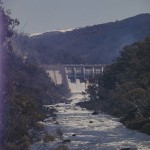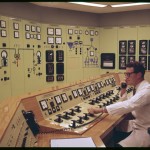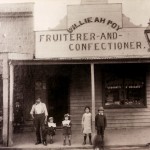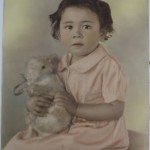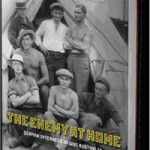Cross-section of the Snowy Mountains Hydro Electric Scheme, Powerhouse Museum Collection The building of the Snowy Mountains Hydro-Electric Scheme was a pivotal event in Australia’s history. Not only did it create one of the engineering wonders of the modern world, … Continue reading
Island Bend Dam, Courtesy National Archives Australia On its completion in 1974 the Snowy Hydro-Electric Scheme had employed over one hundred thousand. In harsh and dangerous conditions, they built a new future for themselves and for the nation. Many families … Continue reading
Snowy Mountains Authority Workers. Courtesy National Archives of Australia Karl Rieck was recruited in Germany by the Snowy Mountains Authority. Despite his Carpenter’s Guild membership, he had to pass a Snowy Mountains Authority carpentry test by making wooden louvers. When … Continue reading
The Scheme’s Control Room, c.1960s. Courtesy State Library of New South Wales. In 1949 many migrants with engineering or construction skills and experience in working alpine conditions were targeted for the Snowy Mountains Hydro-Electric Scheme. Dams, power stations and tunnels … Continue reading
There are supporting primary and secondary education kits available from the Museum of the Riverina website. Through this exhibition and education kits students will discover a variety of aspects of the Chinese Australian migrant experience including work, leisure, family life, … Continue reading
Bookmark on DeliciousRecommend on FacebookShare with StumblersTweet about it
Executive Producers John Petersen, NSW Migration Heritage Centre and Madeleine Scully, Museum of the Riverina Historical research, Dr Barry McGowan Exhibition curators, Dr Barry McGowan & Genevieve Mott, Museum of the Riverina Web production and design Annette Loudon based on … Continue reading
Willie Ah Poy and children Walter, Ruby In the mid to late nineteenth century a combination of powerful push and pull factors led to an unprecedented rise in Chinese migration to other parts of Asia, the Americas and Australia. … Continue reading
Despite the racial tensions of the late nineteenth century many Chinese people won a measure of acceptance and respectability in the eyes of white Australia, contributing to charities and corporate life, and in turn inviting Europeans to ceremonies such as … Continue reading
Ah Du, Certificate of Domicile, 1903, Wagga The Immigration Restriction Act 1901, and the introduction of the White Australia Policy, had its basis in the earlier colonial immigration restrictions, a resurgent Japan, perceptions of unfair economic competition, and an underlying … Continue reading
Camp life Narrandera resident and huts in the aftermath of a devastating fire, 1897 Much of the predominantly male Chinese population in the Riverina lived in self-contained camps, located on the fringe of the main towns and close to the … Continue reading
Monster meeting of miners, Temora, 1883 The Chinese were not always welcome in Australia and were constantly reminded of their allegedly inferior status. The most commonly cited acts of discrimination and prejudice against the Chinese in Australia were the Lambing … Continue reading
From gold to Pastoral labourers Ringbarking camp, near Deniliquin The first Chinese people to arrive in Australia in any number came as indentured labourers in 1847, and worked primarily on pastoral properties. It was not until the 1851 gold rushes, … Continue reading
The Chinese migrants brought their traditions, beliefs and clan linkages with them. Those arriving on the ‘credit-ticket system’ were monitored by headmen or bosses, in association with fraternal organisations such as native-place associations and hui or secret societies. An extensive … Continue reading
Meet Sardool Singh and see the violin given to him by his father. Continue reading
Meet Marius de Vos and see the newspaper clipping of his family’s arrival from Holland in 1960. Continue reading
Meet Moses Aaron and see his father’s book on Moses. Continue reading
Meet Joseph Borg and see his Maltese George Cross ashtray made from recycled WW2 mortars. Continue reading
Bookmark on DeliciousRecommend on FacebookShare with StumblersTweet about it
Bookmark on DeliciousRecommend on FacebookShare with StumblersTweet about it
Original concept, curator and project management Stephen Thompson Web concept, design and programming Annette Loudon based on the exhibition design by Cathy Osborne Historic Houses Trust liaison Beth Hise & Bob Whight © 2011 Migration Heritage Centre: Powerhouse Museum Bookmark … Continue reading
The Enemy at Home: German internees in WWI Australia Nadine Helmi and Gerhard Fischer When nearly 7,000 people of German and Austrian descent were detained in Australian during World War I, talented Bavarian photographer Paul Dubotzki was among them. These … Continue reading
» Germantowns, Germanstories » The Effects of the First World War on Australia’s German-speakers » German Australian » World War I » Objects Through Time – Internment » The Enemy at Home exhibition next » Bookmark on DeliciousRecommend on FacebookShare … Continue reading
List of internment camps that are currently visibly on map (this changes as you zoom in and out) : Bookmark on DeliciousRecommend on FacebookShare with StumblersTweet about it
Links to Objects Through Time Statements of Significance: » Holsworthy Collection » Berrima Collection » Trial Bay Collection » Jindera Collections » Temora Collections » Museum of the Riverina Collection next » Bookmark on DeliciousRecommend on FacebookShare with StumblersTweet about … Continue reading
Case of the Enemy Aliens – Secondary education kit Teacher’s guide for Stages 4 and 5 of the New South Wales History syllabus More info » Zivil Lager (PDF) Download the Trial Bay Gaol internment Camp history booklet. download … Continue reading
Fisher, G. Enemy Aliens: Internment and The Homefront Experience in Australia, 1914-1920. Queensland, 1989. Harmstorf, I & Cigler, M. The Germans in Australia, Melbourne. 1985. McKernan, M. The Australian People and the Great War, Sydney, 1984. Meyer, C. A History … Continue reading
The Enemy at Home experience of the German Australian Community is interesting as the first Germans came to the colonies on the First Fleet, and by 1900 they were the fourth-largest European ethnic group in all the colonies, behind the … Continue reading
Liverpool Internment Camp 1914 – 1918 post card. Dubotzki collection, Germany. Holsworthy Internment Camp, c.1915. Dubotzki collection, Germany The largest internment camp in Australia during World War One was at Holsworthy, near Liverpool on the outskirts of Sydney. The camp … Continue reading
Kriegsgefangenen- Lager Berrima, Drawn by Menke 28th September 1917. Dubotzki collection, Germany Berrima roll call, April 1916. Dubotzki collection, Germany Internees at Moss Vale Railway Station March, 1915. Courtesy of the Berrima District Museum In March 1915 the first group … Continue reading
